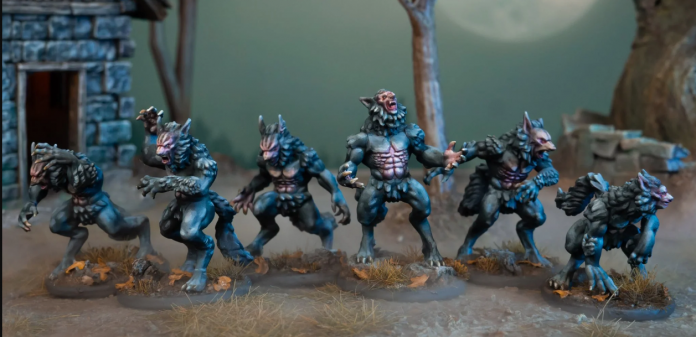Thank you to Wargames Atlantic for providing a box of their Classic Fantasy: Werewolves for review. If you’d like to pick up this kit and support Goonhammer while you’re at it, get it through our affiliate link.
The Contents
Each box of werewolves contains 20 models, with five half-size sprues containing four models each, along with various heads and arms to go with each werewolf body.
At first glance, this looks like a ton of variety on the sprue, but once I dug into it I found that the kit ends up being a bit samey. While the promo shots on the product page only use the classic, upright head back howling werewolf once, that body is one of the four on the sprue, so fully a fifth of your werewolves are going to look like that. In practice I haven’t found this to be much of an issue since I’m never really using all 20 models at once, but it’s something to keep in mind if you’d like to use the kit for some kind of mass battle system.
The arms aren’t fully interchangeable without some work, which limits the variety you’ll get for each pose unless you want to put in a bit of knife and greenstuff work. The separate tails are a nice touch, giving a bit of detail that’s small but does a lot of work in changing the silhouette of the model and making them a bit distinct.
One final nitpick I have (which is more of an issue of false expectations) is that I wish the heads were more traditionally sculpted, with a full front and back of the head as a self-contained piece, so that I could kitbash them with other kits. I had daydreamed about throwing some werewolf heads on space marine bodies as a goof, but that’s not possible with the way these models are put together. The heads look good on the bodies, don’t get me wrong, I just wish I could use them outside of the kit itself.
The Build
Everything goes together really well, with the caveat that you’ll need to dry fit some arms before you get out the glue. I tend to work one model at a time, cutting out a body, head, arms, and tail and cleaning and assembling before moving on, and with this kit that meant I needed a little container to hold spare parts when I’d cut them out and they wouldn’t quite fit like I wanted. The arms and heads are pretty posable, and avoid the issue of having one “golden angle” where they look good on a body. It’s pretty trivial to rotate an arm to whatever pose you’d like and differentiate the different models that way. There are no instructions, and you don’t really need them if you’ve ever built wargaming models before, but I would have appreciated at least a Victrix-style little document that says which parts are compatible with which bodies without any extra work.
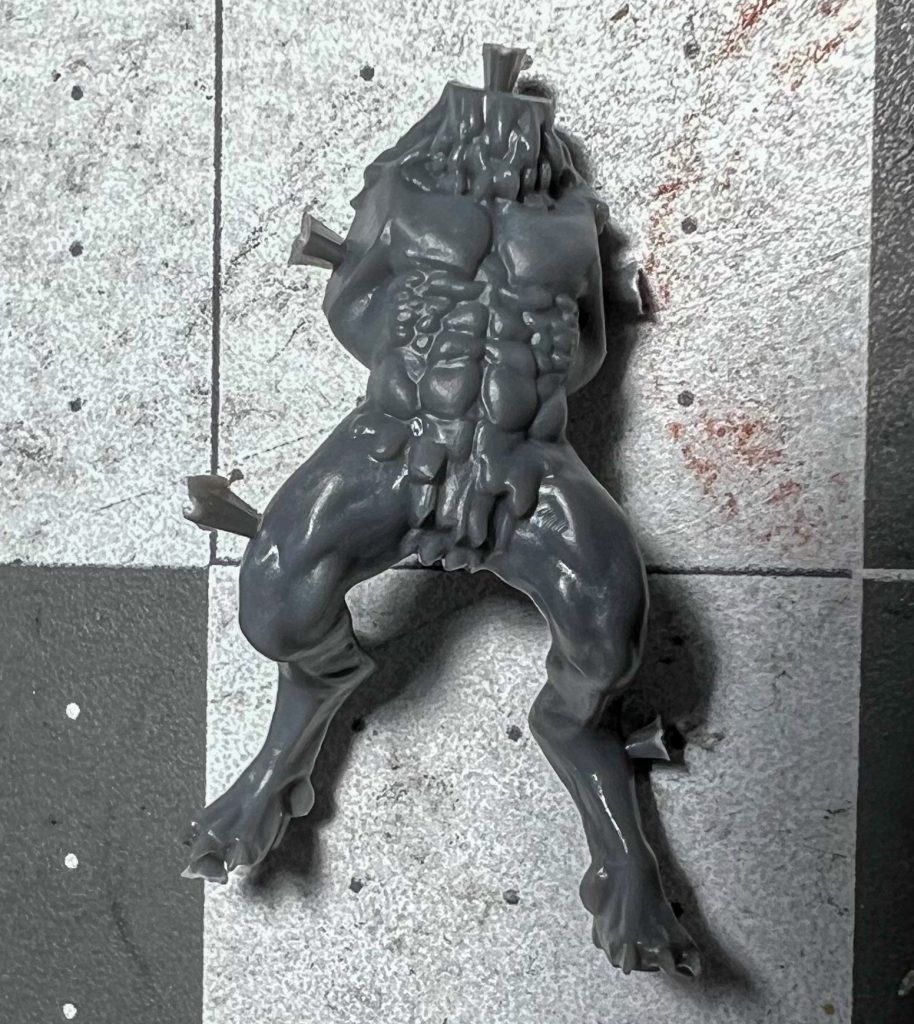
My only real nitpick is in the cleanup stage. If you look at the sprue, you can see that each werewolf body is attached to the sprue at five different points, and almost all in spots that are visible or where you’ll need to join parts, so you’ll need to spend a lot of time making each model look presentable. This is where most of the time building the kit is spent, between filing down gates and scraping mold lines. Everything else is super simple.

The werewolves scale very well with traditionally-sized, more “realistic” 28mm models. They’ll look small next to a space marine, but look great with historicals, a lot of non-GW army lines, and RPG models. More on this later.
Painting and Basing
These werewolves were a joy for me to paint. They’re composed entirely of two of my favorite things to paint on a model: skin and hair. The details are crisply molded, so contrast paints and washes work wonders. If a GM wanted to pick up a box of these and get a handful painted overnight for an RPG session on the weekend, they’re perfect for that.
That’s not to say there isn’t a learning curve for them. I was on the fence about sharing this, but the first test model I painted is one of the most cursed things I’ve ever done and it’s just too funny looking not to. I don’t think we share our failures enough in general in hobby spaces; they’re a good reminder that everyone screws up sometimes and that you can always just start over, nothing’s ever ruined for good.
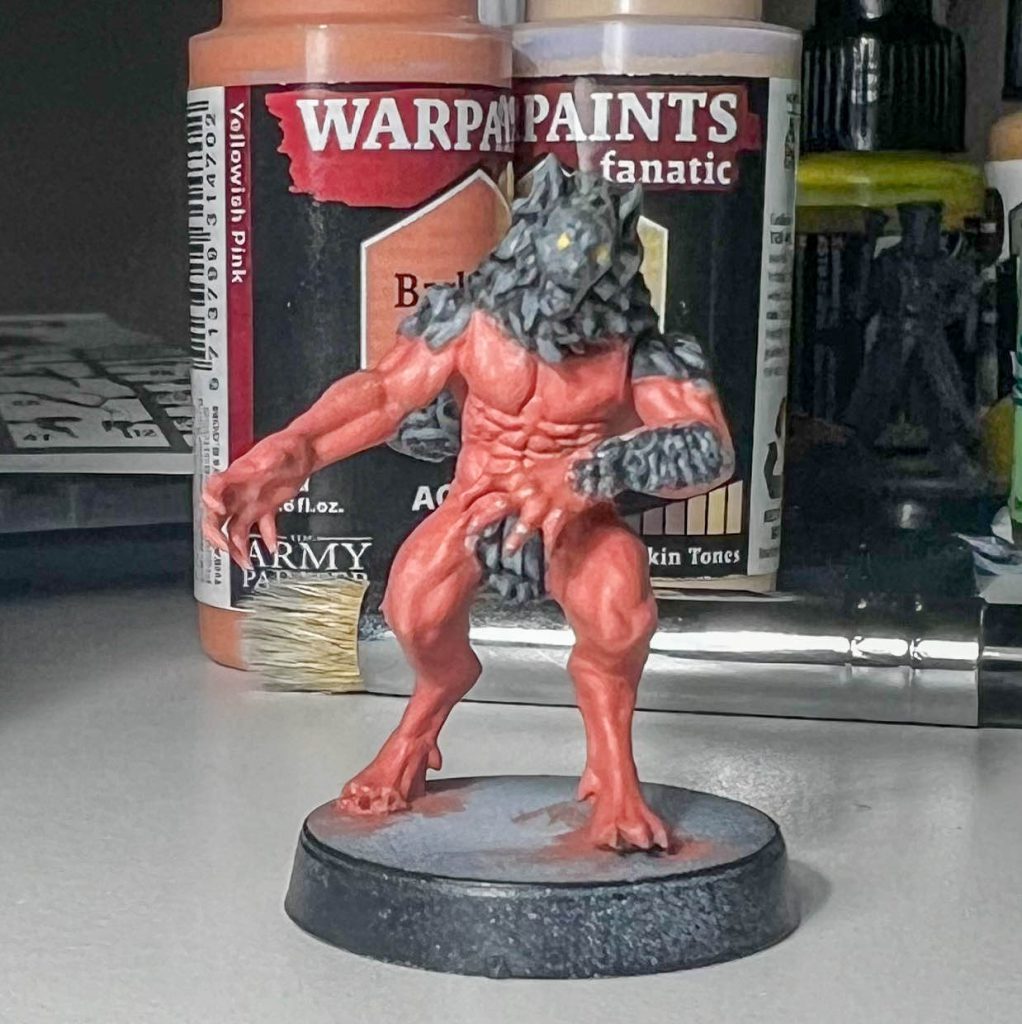
I don’t know why I thought that all flesh tones except for the modeled tufts of hair would look good, but it’s so weird and off putting that I couldn’t keep it like this even as a gag. Someone with more skill than me could maybe pull this scheme off as a body horror kinda thing but that’s not my bag at all. I eventually settled on two different schemes: one with gray flesh and dark hair, traditionally painted, and one that just tries to blend various contrast browns together to get some transitions between fur and flesh. I am far from a great painter, so if you want to see someone with real skill take these on, I suggest looking at the product page for shots, they’re all wonderfully done.
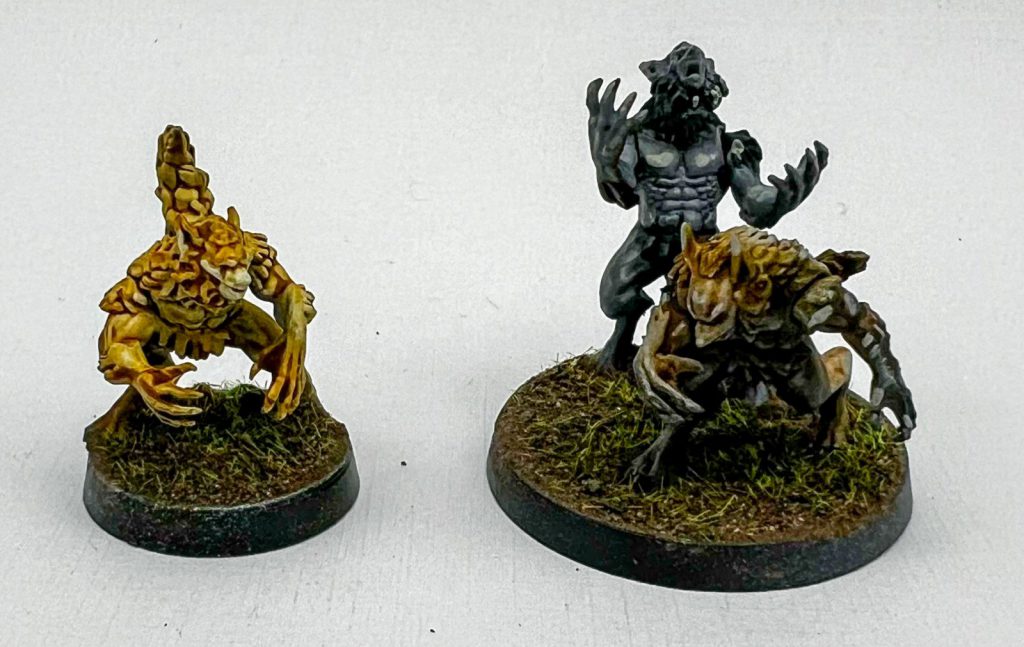
I think these look much better without any traditional flesh tones at all, although I really do like the product page shots where they blend the flesh tones into the gray of the werewolf fur, and I’d definitely recommend going for that route if you have the time and would like to attempt it.
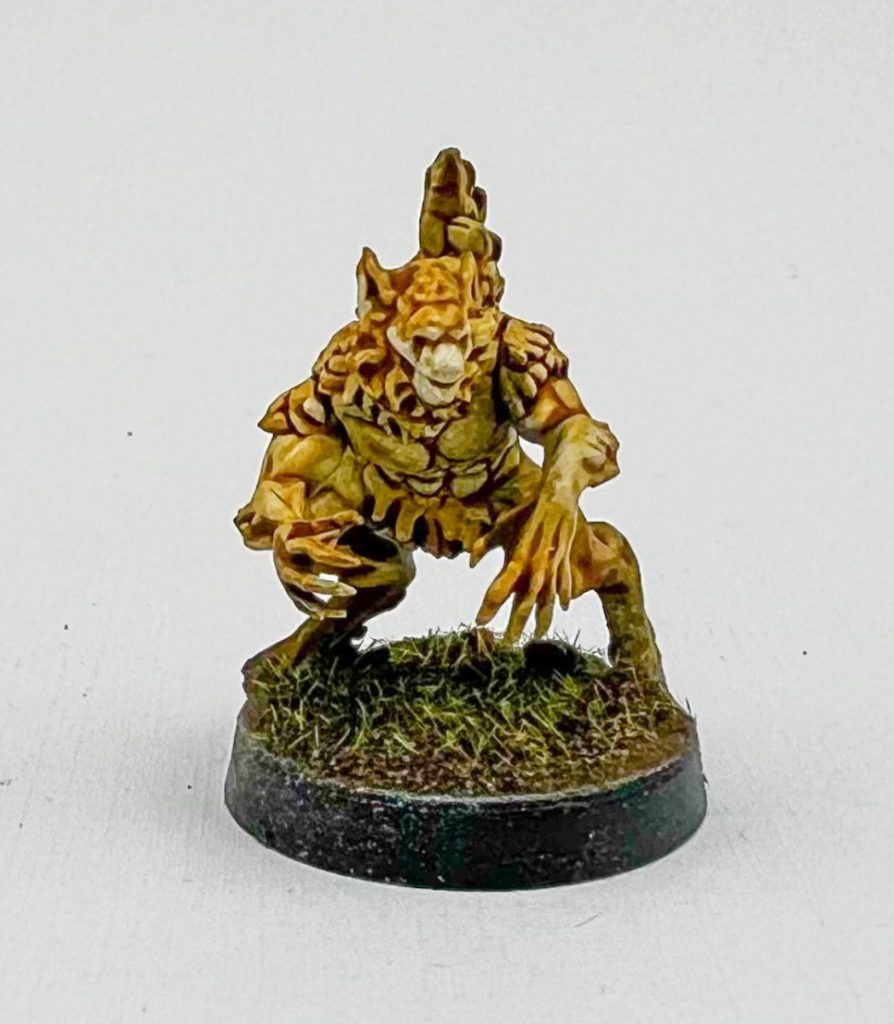
The blonde, golden retriever-esque werewolf ended up being my favorite, and also the easiest to paint. It’s a blend of Vallejo Express Mummy White on the skin parts, and Vallejo Express Bag of Bones on the fur. The longer working time from the express colors makes it pretty simple to wet blend the colors together, and the deep, sharp recesses take contrast-style paints super well. I did a final highlight with a bit of Army Painter Fanatic Brainmatter Beige to give a bit more definition and tie it together with the other models I painted.
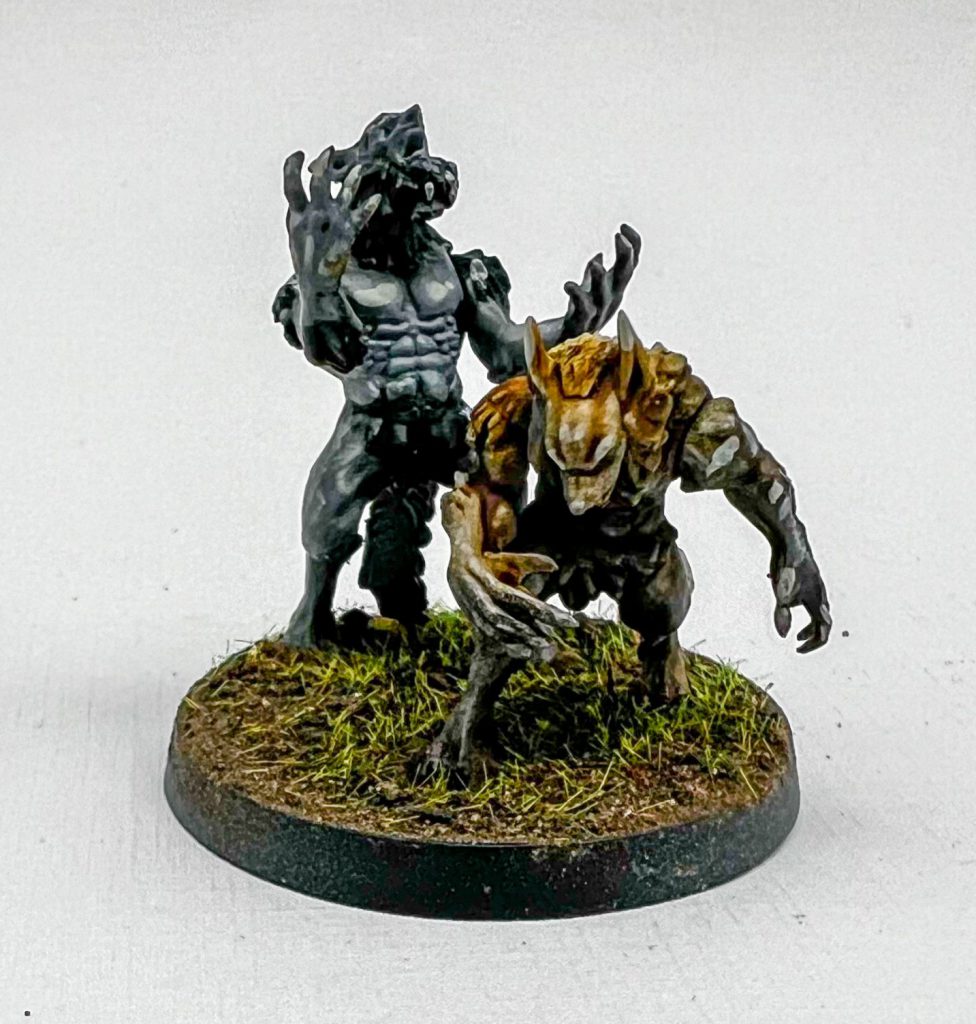
For the grey and black werewolf I used the Army Painter Warpaints Fanatic Black and Grey flexible triad, basecoating with Deep Grey and Matt Black, highlighting with Ash Grey and then switching to the warm gray triad to do a final highlight with Brainmatter Beige that I repeated on the brown werewolf to give everything a cohesive look. The brown werewolf is a mix of Vallejo Express Mahogany and Battledress Brown, as I wanted to try out some dark colors on the models. Everything was then based with a layer of Turned Earth Ground from Ammo by Mig and some Pine Forest Ground Cover from Luke’s APS.
I really enjoyed painting these, and I think they will reward as much effort as you want to put into them. The nature of everything being flesh and fur gives you a lot of opportunities for subtle blends if you want to try those transitions, and you can really spend a lot of time going all out and highlighting every individual muscle and tuft of hair. Wargames Atlantic managed to strike a great balance with the sculpting of this kit that will make painters of all skill levels feel good about what they’ve accomplished.
So What Are You Using Them For?
When these were first announced, the thing I kept hearing from friends in miniature wargaming spaces was “those are cool looking, but I don’t know where I’d use them,” and I think that’s a pretty valid stance. Wargames Atlantic doesn’t make a fantasy wargame for these, so nobody’s making an army list that requires a box. As soon as I got the box, I started thinking of things to use them for, and quickly found that I will be spreading the box across at least three different games, and had a bunch of ideas for games I don’t play.
The first use I thought of would be for fantasy RPGs. They’re similar in size to miniature lines like Nolzur’s from Wizkids, so an enterprising DM could make good use of these. They might not need 20 of them, but they’ll work great. I based the individual werewolves I painted on 25mm bases, and those fit perfectly into the 1” squares RPG mats tend to use.
I based two werewolves on a 40mm round as an experiment to see how well they’d work as an alternative to the Mantic Werewolves for Kings of War, which come on a 40mm square base. The Wargames Atlantic models are smaller, but I think they look pretty cool two to a base, and you’d get three regiments worth in a box for the same price as one regiment directly from mantic. If you want more of a big pack look for your werewolves I’d definitely recommend them for that.
Personally, I’m going to use most of the werewolves in two places: Warriors in a Saga – Age of Magic list and as monsters for Silver Bayonet games. The Saga army is a bit of a gimme, you can use anything there, it’s what the game is built for. I’m using them as warriors in a Lords of the Wild army, taking them in groups of eight to represent a pack coming out of a forest and falling upon their enemy. Silver Bayonet just explicitly has werewolves in it, making that an easy choice. There’s a ton of places to use them once you look past mass battle games.
Final Thoughts
This is a very solid kit, with my only real issue being that the poses will get repetitive when you have more than eight models on the table. Everything is easy to build, they paint up quick, and the sculpts are solid. I kinda wish Wargames Atlantic sold them by the sprue, as I think there are plenty of people who might want a handful of werewolves but not a whole box of 20. Just selfishly, I’d like to get an extra sprue to get 24 total and run them as a couple units of Levy in Saga, but that’s a me problem. I don’t know that I would buy these just to paint up as a modeling project or anything, but if you play any of a number of games where you could use some werewolves these will serve you very well. Maybe split a box with a friend if you only need a few.
Have any questions or feedback? Drop us a note in the comments below or email us at contact@goonhammer.com. Want articles like this linked in your inbox every Monday morning? Sign up for our newsletter. And don’t forget that you can support us on Patreon for backer rewards like early video content, Administratum access, an ad-free experience on our website and more.
